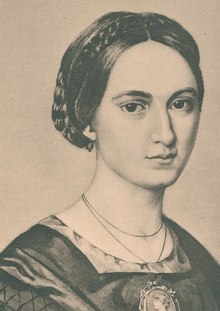Milica Stojadinović-Srpkinja
Milica Stojadinović-Srpkinja | |
|---|---|
 Portrait of poet Milica Stojadinović-Srpkinja | |
| Born | 6 July 1828 |
| Died | 25 July 1878 (aged 50)[1] |
| Occupation | Poet |
Milica Stojadinovic-Srpkinja (Serbian Cyrillic: Милица Стојадиновић Српкиња, pronounced [mîlitsa stɔjadǐːnɔv̞itɕ sr̩̂pkiɲa]) (1828–1878) was a Serbian poet, sometimes called "the greatest female Serbian poet of the 19th century".
Career[edit]
As her fame spread beyond the confines of Serbian culture of the Austrian Empire, Prince Mihailo Obrenović would invite her to court when she came to Belgrade and Vienna-based anthropologist and poet Johann Gabriel Seidl devoted a poem to her.
She corresponded extensively with writers Đorđe Rajković (1825–1886), Ljubomir Nenadović, Vuk Stefanović Karadžić and his daughter Wilhelmine/Mina, Božena Němcová, and with Ludwig August von Frankl. In 1891 an almanach Die Dioskuren was issued in Vienna by Ludwig von Frankl with a collection of letters written by Milica Stojadinović.
Reception[edit]

Her work, though, has been mostly out of the public eye and almost forgotten except by literary experts for most of the 20th century, first during fin-de-siècle modernist poeticism as an outdated poetic form of pre-1870s, and later, under Communist rule as an unacceptable expression of patriotism for only one of the six nations of Yugoslavia (namely: Serbian).
After Josip Broz Tito's death the awareness of her work was revived, and in the last quarter of a century a four-day poetry memorial is convened annually in Novi Sad in her honour, where a poetry prize bearing her name is awarded to prominent poets from Serbia.
Biljana Dojčinović has written on the role of Stojadinović-Srpkinja in the development of women's writing in Serbia, through a feminist framework.[2]
See also[edit]
Notes[edit]
References[edit]
- ^ Božidar Kovaček (1971). Živan Milisavac (ed.). Jugoslovenski književni leksikon [Yugoslav Literary Lexicon] (in Serbo-Croatian). Novi Sad (SAP Vojvodina, SR Serbia): Matica srpska. p. 510.
- ^ Cornis-Pope, Marcel; Neubauer, John (2010-09-29). History of the Literary Cultures of East-Central Europe: Junctures and disjunctures in the 19th and 20th centuries. Volume IV: Types and stereotypes. John Benjamins Publishing. p. 154. ISBN 978-90-272-8786-1.
- Jovan Skerlić, Istorija Nove Srpske Književnosti / History of Modern Serbian Literature (Belgrade, 1914, 1921), p. 208. Her biography was translated from Skerlić's Serbian into English for this entry in the Wikipedia.

